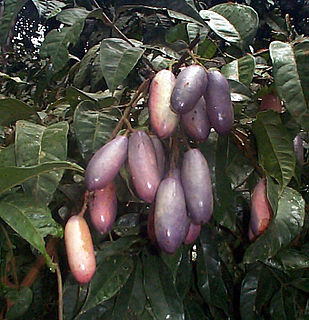
Dacryodes is a genus of about 60 species of trees in the family Burseraceae. The generic name is from the Greek dakruon meaning "tear(drop)", referring to how resin droplets form on the bark surface.

Irvingia malayana, also known as wild almond or barking deer’s mango, is a tropical evergreen tree species in the family Irvingiaceae. The specific epithet malayana is from the Latin meaning "of Malaya".
Madhuca korthalsii is a tree in the family Sapotaceae. It is named for the Dutch botanist P. W. Korthals.
Xanthophyllum obscurum is a tree in the family Polygalaceae. The specific epithet obscurum is from the Latin meaning "dark", referring to the dark colour of the dried flowers and fruits.
Xanthophyllum rufum is a plant in the family Polygalaceae. The specific epithet rufum is from the Latin meaning "reddish", referring to the colour of the twig hairs.
Xanthophyllum stipitatum is a plant in the family Polygalaceae. The specific epithet stipitatum is from the Latin meaning "stalked", referring to the ovary of the flower.
Canarium apertum is a tree in the family Burseraceae. The specific epithet apertum is from the Latin meaning "open", referring to the basal openings between petals.
Canarium grandifolium is a tree in the family Burseraceae. The specific epithet grandifolium is from the Latin meaning "large leaf".
Canarium pilosum is a tree in the family Burseraceae. The specific epithet pilosum is from the Latin meaning "hairy", referring to the soft hairs of the twigs and leaves.
Dacryodes costata is a tree in the family Burseraceae. The specific epithet costata is from the Latin meaning "ribbed", likely referring to the prominent veins on the leaf underside.
Dacryodes elmeri is a tree in the family Burseraceae. It is named for the American botanist Adolph Elmer.
Dacryodes expansa is a tree in the family Burseraceae. The specific epithet expansa is from the Latin meaning "spread out", referring to the structure of the petals.
Dacryodes incurvata is a tree in the family Burseraceae. The specific epithet incurvata is from the Latin meaning "bending inward", referring to the leaflet margin.
Dacryodes laxa is a tree in the family Burseraceae. The specific epithet laxa is from the Latin meaning "loose", referring to the inflorescence.
Dacryodes longifolia is a tree in the family Burseraceae. The specific epithet longifolia is from the Latin meaning "long leaf".
Dacryodes macrocarpa is a tree in the family Burseraceae. The specific epithet macrocarpa is from the Greek meaning "large fruit".
Dacryodes nervosa is a tree in the family Burseraceae. The specific epithet nervosa is from the Latin meaning "with nerves", referring to the leaves.

Dacryodes rostrata is a tree in the family Burseraceae. The specific epithet rostrata is from the Latin meaning "beaked", referring to the narrow-tipped leaves.
Dacryodes rugosa is a tree in the family Burseraceae. The specific epithet rugosa is from the Latin meaning "wrinkled", referring to the leaflets.
Dacryodes rugosa var. virgata is a tree in the family Burseraceae.


